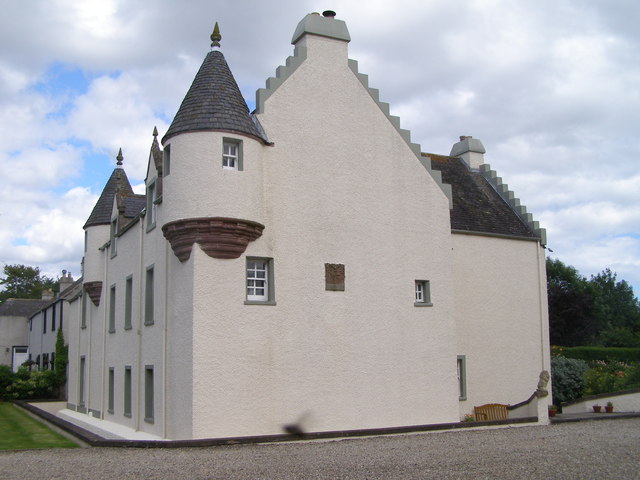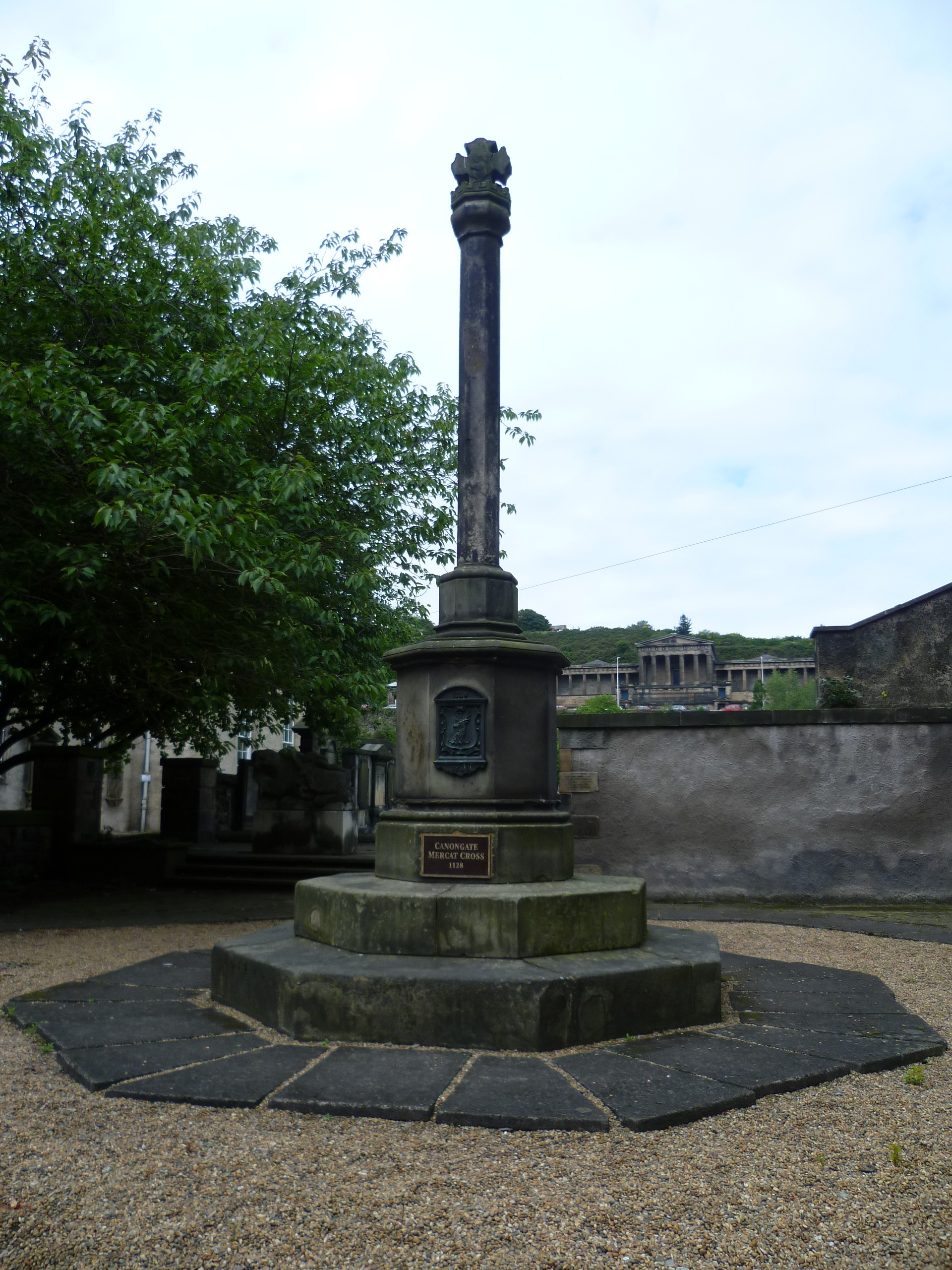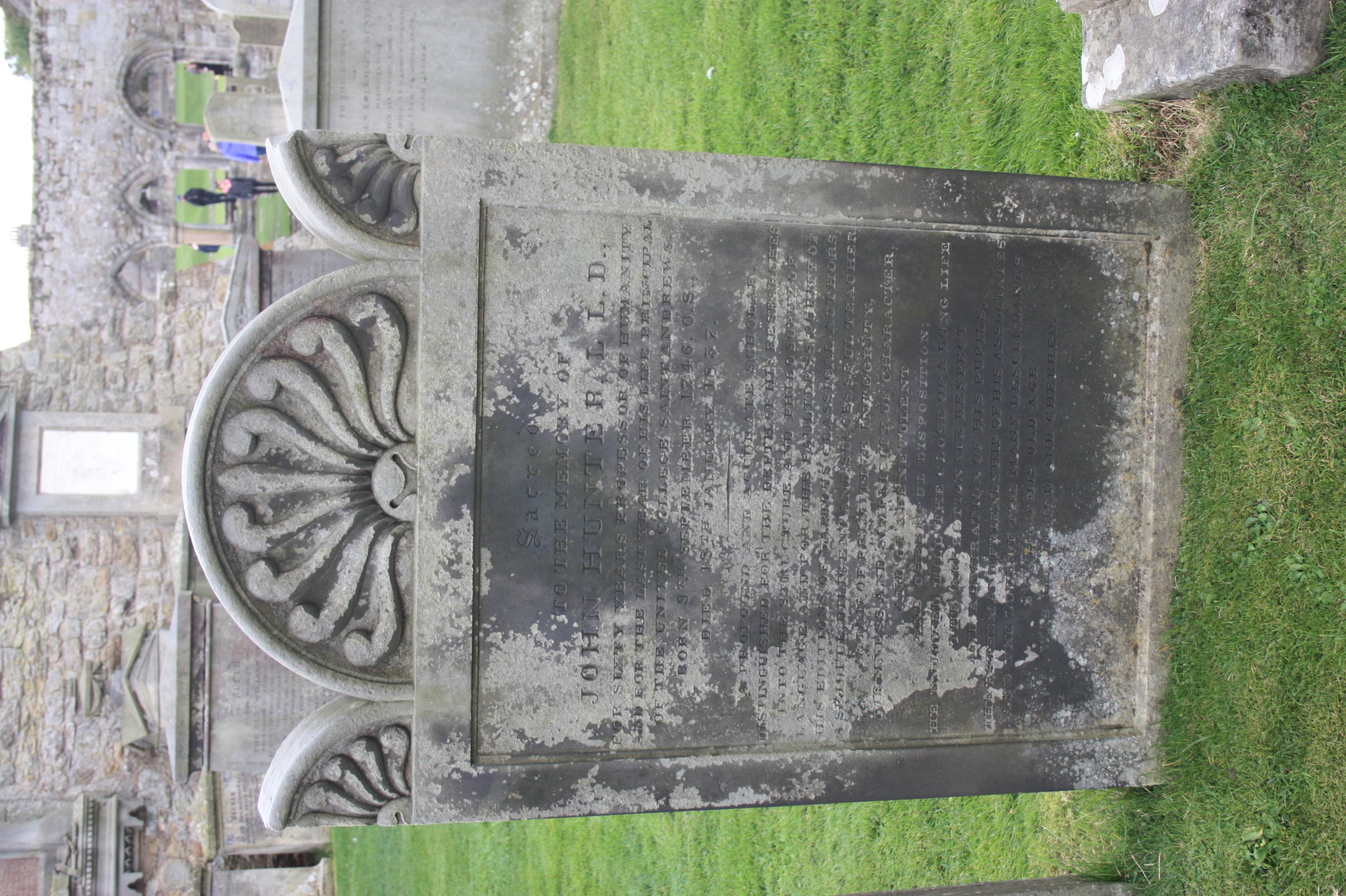|
James Burnett, Lord Monboddo
James Burnett, Lord Monboddo (baptised 25 October 1714; died 26 May 1799) was a Scottish judge, scholar of linguistic evolution, philosopher and deist. He is most famous today as a founder of modern comparative historical linguistics. In 1767 he became a judge in the Court of Session. As such, Burnett adopted an honorary title based on the name of his father's estate and family seat, Monboddo House. Monboddo was one of a number of scholars involved at the time in development of early concepts of biological evolution. Some credit him with anticipating in principle the idea of natural selection that was read by (and acknowledged in the writings of) Erasmus Darwin. Charles Darwin read the works of his grandfather Erasmus and later developed the ideas into a scientific theory. Early years James Burnett was born in 1714 at Monboddo House in Kincardineshire, Scotland. After his primary education at the parish school of Laurencekirk, he studied at Marischal College, Aberdeen, fro ... [...More Info...] [...Related Items...] OR: [Wikipedia] [Google] [Baidu] |
Monboddo House
Monboddo House () is a historically famous mansion in The Mearns, Scotland. The structure was generally associated with the Burnett of Leys family. The property itself was owned by the Barclay family from the 13th century, at which time a tower house structure was erected. In 1593, the Laird was James Strachan, and thence it passed into the Irvine family and thereafter the Burnetts of Leys. There is a notable datestone adornment on the structure with the arms of Irvine impaling the arms of Douglas with initials R.E. and I.E. and dated 1635, representing the 17th-century couple who reconstructed the house, Robert Ervine ( ''sic'') and Ilizabeth Ervine ( ''sic''). Monboddo House, with its crow-stepped gable design, is situated in the Howe of Mearns near the village of Auchenblae approximately nine miles (14 km) from the North Sea. The original landholding of the Monboddo Estate was approximately . In 1714 the well-known judge and philosopher James Burnett, Lord Monb ... [...More Info...] [...Related Items...] OR: [Wikipedia] [Google] [Baidu] |
Faculty Of Advocates
The Faculty of Advocates is an independent body of lawyers who have been admitted to practise as advocates before the courts of Scotland, especially the Court of Session and the High Court of Justiciary. The Faculty of Advocates is a constituent part of the College of Justice and is based in Edinburgh. Advocates are privileged to plead in any cause before any of the courts of Scotland, including the sheriff courts and district courts, where counsel are not excluded by statute. History The Faculty has existed since 1532 when the College of Justice was set up by Act of the Parliament of Scotland, but its origins are believed to predate that event. No curriculum of study, residence or professional training was, until 1856, required on entering this profession, but the faculty always had the power of rejecting any candidate for admission. Subsequently candidates underwent two private examinations; one in general scholarship that could be substituted by evidence of an equivalen ... [...More Info...] [...Related Items...] OR: [Wikipedia] [Google] [Baidu] |
Hampton Court
Hampton Court Palace is a Grade I listed royal palace in the London Borough of Richmond upon Thames, southwest and upstream of central London on the River Thames. The building of the palace began in 1514 for Cardinal Thomas Wolsey, the chief minister of Henry VIII. In 1529, as Wolsey fell from favour, the cardinal gave the palace to the king to check his disgrace. The palace went on to become one of Henry's most favoured residences; soon after acquiring the property, he arranged for it to be enlarged so that it might more easily accommodate his sizeable retinue of courtiers. Along with St James' Palace, it is one of only two surviving palaces out of the many the king owned. The palace is currently in the possession of King Charles III and the Crown. In the following century, King William III's massive rebuilding and expansion work, which was intended to rival the Palace of Versailles, destroyed much of the Tudor palace.Dynes, p. 90. His work ceased in 1694, leaving the pala ... [...More Info...] [...Related Items...] OR: [Wikipedia] [Google] [Baidu] |
Henry Home, Lord Kames
Henry Home, Lord Kames (169627 December 1782) was a Scottish writer, philosopher, advocate, judge, and agricultural improver. A central figure of the Scottish Enlightenment, a founding member of the Philosophical Society of Edinburgh, and active in the Select Society, he acted as patron to some of the most influential thinkers of the Scottish Enlightenment, including the philosopher David Hume, the economist Adam Smith, the writer James Boswell, the chemical philosopher William Cullen, and the naturalist John Walker. Biography He was born at Kames House, between Eccles and Birgham, Berwickshire, son of George Home of Kames House. He was educated at home by a private tutor until the age of 16. In 1712 he was apprenticed as a lawyer under a Writer to the Signet in Edinburgh, was called to the Scottish bar as an advocate bar in 1724. He soon acquired reputation by a number of publications on the civil and Scottish law, and was one of the leaders of the Scottish Enlighte ... [...More Info...] [...Related Items...] OR: [Wikipedia] [Google] [Baidu] |
Canongate
The Canongate is a street and associated district in central Edinburgh, the capital city of Scotland. The street forms the main eastern length of the Royal Mile while the district is the main eastern section of Edinburgh's Old Town. It began when David I of Scotland, by the Great Charter of Holyrood Abbey c.1143, authorised the Abbey to found a burgh separate from Edinburgh between the Abbey and Edinburgh. The burgh of Canongate that developed was controlled by the Abbey until the Scottish Reformation when it came under secular control. In 1636 the adjacent city of Edinburgh bought the feudal superiority of the Canongate but it remained a semi-autonomous burgh under its own administration of bailies chosen by Edinburgh magistrates, until its formal incorporation into the city in 1856. The burgh gained its name from the route that the canons of Holyrood Abbey took to Edinburgh—the canons' way or the canons' gait, from the Scots word ''gait'' meaning "way". In more modern ... [...More Info...] [...Related Items...] OR: [Wikipedia] [Google] [Baidu] |
Parliament House, Edinburgh
Parliament House ( gd, Taigh na Pàrlamaid) in the Old Town, Edinburgh, Old Town in Edinburgh, Scotland, is a complex of several buildings housing the Supreme Courts of Scotland. The oldest part of the complex was home to the Parliament of Scotland from 1639 to 1707, and is the world's first purpose-built parliament building. Located just off the Royal Mile, beside St Giles' Cathedral, Parliament House is also the headquarters of the Faculty of Advocates, the Society of Writers to His Majesty's Signet, and the Society of Solicitors in the Supreme Courts of Scotland. Other buildings in the complex include the Advocates Library and the Society_of_Writers_to_His_Majesty%27s_Signet#The_Signet_Library, Signet Library. The entire complex is a Category A Listed building. History In the 17th century, the Parliament of Scotland did not have a dedicated permanent home. Between 1438 and 1561, it had usually met in the Old Tolbooth, Edinburgh, Tolbooth in Edinburgh, a building which al ... [...More Info...] [...Related Items...] OR: [Wikipedia] [Google] [Baidu] |
John Hunter (classicist)
John Hunter FRSE (7 September 1746 – 18 January 1837) was a Scottish classicist and horticulturalist. In 1783 he was a joint founder of the Royal Society of Edinburgh. Life Hunter was born in Closeburn, Dumfries and Galloway on 7 September 1746. He was educated nearby at Wallace Hall School. He was then attended the University of Edinburgh, graduation with an MA in 1768. His first role was as private secretary to Lord Monboddo. In 1775 he then accepted the role of Professor of Humanity at the United College in University of St Andrews, continuing in this role until 1826. In 1826 (aged 80) he took on the role of Principal of the twin colleges of St Leonards and St Salvators at the University. The University of Edinburgh awarded him an honorary doctorate (LLD) in later life. He died at St Andrews on 18 January 1837, and is buried in St Andrews Cathedral churchyard. Family He married twice, firstly around 1770 to Elizabeth Miln and together they had a son, James Hunter (177 ... [...More Info...] [...Related Items...] OR: [Wikipedia] [Google] [Baidu] |
David Hume
David Hume (; born David Home; 7 May 1711 NS (26 April 1711 OS) – 25 August 1776) Cranston, Maurice, and Thomas Edmund Jessop. 2020 999br>David Hume" ''Encyclopædia Britannica''. Retrieved 18 May 2020. was a Scottish Enlightenment philosopher, historian, economist, librarian, and essayist, who is best known today for his highly influential system of philosophical empiricism, scepticism, and naturalism. Beginning with '' A Treatise of Human Nature'' (1739–40), Hume strove to create a naturalistic science of man that examined the psychological basis of human nature. Hume argued against the existence of innate ideas, positing that all human knowledge derives solely from experience. This places him with Francis Bacon, Thomas Hobbes, John Locke, and George Berkeley as an Empiricist. Hume argued that inductive reasoning and belief in causality cannot be justified rationally; instead, they result from custom and mental habit. We never actually perceive that one event caus ... [...More Info...] [...Related Items...] OR: [Wikipedia] [Google] [Baidu] |
Canongate Books
Canongate Books (trading as Canongate) is an independent publishing firm based in Edinburgh, Scotland. It is named after the Canongate area of the city. It is most recognised for publishing the Booker Prizewinner ''Life of Pi''. Canongate was named the British Book Awards Publisher of the Year in 2003 and 2009. Origins Canongate was founded in 1973 by Stephanie Wolfe Murray and her husband Angus Wolfe Murray. Originally a speciality press focusing on Scottish-interest books, generally with small print runs, its most major author was Alasdair Gray. In 1994 it was purchased from the receiver in a management buyout led by Jamie Byng, using funds provided by his stepfather Christopher Bland and his father-in-law Charlie McVeigh, and began to publish more general works, including the '' Pocket Canons'' editions of books of the Bible, as well as the ''Payback Press'' and '' Rebel Inc.'' imprints. Byng is now the Publisher and Managing Director of the company. In June 2010 it was anno ... [...More Info...] [...Related Items...] OR: [Wikipedia] [Google] [Baidu] |
The Grave Of Lord Patrick Grant, Greyfriars Kirkyard
''The'' () is a grammatical article in English, denoting persons or things that are already or about to be mentioned, under discussion, implied or otherwise presumed familiar to listeners, readers, or speakers. It is the definite article in English. ''The'' is the most frequently used word in the English language; studies and analyses of texts have found it to account for seven percent of all printed English-language words. It is derived from gendered articles in Old English which combined in Middle English and now has a single form used with nouns of any gender. The word can be used with both singular and plural nouns, and with a noun that starts with any letter. This is different from many other languages, which have different forms of the definite article for different genders or numbers. Pronunciation In most dialects, "the" is pronounced as (with the voiced dental fricative followed by a schwa) when followed by a consonant sound, and as (homophone of the archaic pron ... [...More Info...] [...Related Items...] OR: [Wikipedia] [Google] [Baidu] |
Archibald James Edward Douglas, 1st Baron Douglas
Archibald James Edward Douglas, 1st Baron Douglas (10 July 1748 – 26 December 1827), was a Scottish politician. Early life He was born Archibald James Edward Stewart, in Paris,G.E. Cokayne; with Vicary Gibbs, H.A. Doubleday, Geoffrey H. White, Duncan Warrand and Lord Howard de Walden, editors, ''The Complete Peerage of England, Scotland, Ireland, Great Britain and the United Kingdom, Extant, Extinct or Dormant, new ed., 13 volumes in 14'' (1910-1959; reprint in 6 volumes, Gloucester, U.K.: Alan Sutton Publishing, 2000), volume IV, page 441. the twin son of Sir John Stewart, 3rd Baronet (1687–1764) and Lady Jane Douglas, daughter of James Douglas, 2nd Marquess of Douglas. The circumstances of the birth were controversial. His mother was the sister of the wealthy Duke of Douglas. As the Duke was childless, his estate would pass to the next in line, the Duke of Hamilton, unless an heir could be found. Lady Jane was 47 when she married the 60-year-old Colonel John Stewart, a ... [...More Info...] [...Related Items...] OR: [Wikipedia] [Google] [Baidu] |
Elegy
An elegy is a poem of serious reflection, and in English literature usually a lament for the dead. However, according to ''The Oxford Handbook of the Elegy'', "for all of its pervasiveness ... the 'elegy' remains remarkably ill defined: sometimes used as a catch-all to denominate texts of a somber or pessimistic tone, sometimes as a marker for textual monumentalizing, and sometimes strictly as a sign of a lament for the dead". History The Greek term ἐλεγείᾱ (''elegeíā''; from , , ‘lament’) originally referred to any verse written in elegiac couplets and covering a wide range of subject matter (death, love, war). The term also included epitaphs, sad and mournful songs, and commemorative verses. The Latin elegy of ancient Roman literature was most often erotic or mythological in nature. Because of its structural potential for rhetorical effects, the elegiac couplet was also used by both Greek and Roman poets for witty, humorous, and satirical subject matter. Oth ... [...More Info...] [...Related Items...] OR: [Wikipedia] [Google] [Baidu] |








.png)